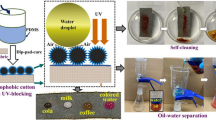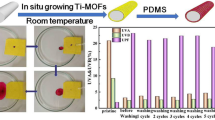Abstract
A simple and feasible method is proposed for the fabrication of a super-hydrophobic coating on cotton fabric via sol–gel process. The wettability of the coating was investigated by water contact angle measurement (WCA). WCA of coated fabric reached up to 161.5 ± 1.02°. The tensile strength and Young’s modulus and mechanical properties of coated fabric is quite promising than uncoated fabric. Moreover, the coated fabric can effectively separate oil–water mixtures through an ordinary filtering process with a separation efficiency of 99%. After 15 cycles of separation the contact angle changes to 155.6 ± 0.98° only and material maintained its super-hydrophobic property. The durability of the coating was evaluated by exposing the specimen at harsh environments like acidic, alkaline, saline, and ultraviolet irradiation was conducted. The tear test was evaluated using the adhesive tape test, abrasion resistance test apart from washing stability and these results suggested that the coating was sufficiently stable. The coated fabric free of fluorine and chlorine can be effectively utilized in various fields.





Similar content being viewed by others
References
J. Hong, W.K. Bae, H. Lee, S. Oh, K. Char, F. Caruso, J. Cho, Tunable superhydrophobic and optical properties of colloidal films coated with block-copolymer-micelles/micelle-multilayers. Adv. Mater. 19, 4364–4369 (2007)
S. Yang, S. Chen, Y. Tian, C. Feng, L. Chen, Facile transformation of a native polystyrene (PS) film into a stable superhydrophobic surface via sol–gel process. Chem. Mater. 20, 1233–1235 (2008)
X.X. Zhang, S. Cai, D. You, L.H. Yan, H.B. Lv, X.D. Yuan, B. Jiang, Template-free sol-gel preparation of superhydrophobic ORMOSIL films for double-wavelength broadband antireflective coatings. Adv. Func. Mater. 23, 4361–4365 (2013)
Q. Wang, T.-A. Asoh, H. Uyama, Facile fabrication of flexible bacterial cellulose/silica composite aerogel for oil/water separation. Bull. Chem. Soc. Jpn. 91, 1138–1140 (2018)
D. Angelova, I. Uzunov, S. Uzunova, A. Gigova, L. Minchev, Kinetics of oil and oil products adsorption by carbonized rice husks. Chem. Eng. J. 172, 306–311 (2011)
P.S. Brown, B. Bhushan, Bioinspired materials for water supply and management: water collection, water purification and separation of water from oil. Philosophic. Trans. R Soc. A 374, 20160135 (2016)
Y. Cao, X. Zhang, L. Tao, K. Li, Z. Xue, L. Feng, Y. Wei, Mussel-inspired chemistry and michael addition reaction for efficient oil/water separation. ACS Appl. Mater. Interfaces 5, 4438–4442 (2013)
Z. Chu, Y. Feng, S. Seeger, Oil/water separation with selective superantiwetting/superwetting surface materials. Angew. Chem. Int. Ed. 54, 2328–2338 (2015)
F. Liu, M. Ma, D. Zang, Z. Gao, C. Wang, Fabrication of superhydrophobic/superoleophilic cotton for application in the field of water/oil separation. Carbohyd. Polym. 103, 480–487 (2014)
J. Zhu, B. Liu, L. Li, Z. Zeng, W. Zhao, G. Wang, X. Guan, Simple and green fabrication of a superhydrophobic surface by one-step immersion for continuous oil/water separation. J. Phys. Chem. A 120, 5617–5623 (2016)
Y. Yu, H. Chen, Y. Liu, V.S. Craig, Z. Lai, Selective separation of oil and water with mesh membranes by capillarity. Adv. Coll. Interface Sci. 235, 46–55 (2016)
J. Wang, Y. Chen, Oil–water separation capability of superhydrophobic fabrics fabricated via combining polydopamine adhesion with lotus-leaf-like structure. J. Appl. Polym. Sci. (2015). https://doi.org/10.1002/app.42614
G. Wang, Z. Zeng, H. Wang, L. Zhang, X. Sun, Y. He, L. Li, X. Wu, T. Ren, Q. Xue, Low drag porous ship with superhydrophobic and superoleophilic surface for oil spills cleanup. ACS Appl. Mater. Interfaces 7, 26184–26194 (2015)
B. Dubansky, A. Whitehead, J.T. Miller, C.D. Rice, F. Galvez, Multitissue molecular, genomic, and developmental effects of the deepwater horizon oil spill on resident Gulf killifish (Fundulus grandis). Environ. Sci. Technol. 47, 5074–5082 (2013)
Z. Xue, Y. Cao, N. Liu, L. Feng, L. Jiang, Special wettable materials for oil/water separation. J. Mater. Chem. A 2, 2445–2460 (2014)
M. Li, F. Chen, C. Liu, J. Qian, Z. Wu, Z. Chen, Electrospun fibrous PTFE supported ZnO for oil-water separation. J. Inorg. Organomet. Polym. Mater. DO 29, 1738–1745 (2019)
J. Ge, D. Zong, Q. Jin, J. Yu, B. Ding, Biomimetic and superwettable nanofibrous skins for highly efficient separation of oil-in-water emulsions. Adv. Func. Mater. 28, 1705051 (2018)
Z. Wang, Y. Xu, Y. Liu, L. Shao, A novel mussel-inspired strategy toward superhydrophobic surfaces for self-driven crude oil spill cleanup. J. Mater. Chem. A 3, 12171–12178 (2015)
Z. Xu, K. Miyazaki, T. Hori, Fabrication of polydopamine-coated superhydrophobic fabrics for oil/water separation and self-cleaning. Appl. Surf. Sci. 370, 243–251 (2016)
H. Zhou, H. Wang, H. Niu, A. Gestos, T. Lin, Robust, self-healing superamphiphobic fabrics prepared by two-step coating of fluoro-containing polymer, fluoroalkyl silane, and modified silica nanoparticles. Adv. Func. Mater. 23, 1664–1670 (2013)
M.E. Yazdanshenas, M. Shateri-Khalilabad, One-step synthesis of superhydrophobic coating on cotton fabric by ultrasound irradiation. Ind. Eng. Chem. Res. 52, 12846–12854 (2013)
I. Das, G. De, Zirconia based superhydrophobic coatings on cotton fabrics exhibiting excellent durability for versatile use. Sci. Rep. 5, 18503 (2015)
M.A. Shirgholami, M.S. Khalil-Abad, R. Khajavi, M.E. Yazdanshenas, Fabrication of superhydrophobic polymethylsilsesquioxane nanostructures on cotton textiles by a solution–immersion process. J. Colloid Interface Sci. 359, 530–535 (2011)
K. Sasaki, M. Tenjimbayashi, K. Manabe, S. Shiratori, Asymmetric superhydrophobic/superhydrophilic cotton fabrics designed by spraying polymer and nanoparticles. ACS Appl. Mater. Interfaces 8, 651–659 (2015)
A. Bouzidi, K. Omri, W. Jilani, H. Guermazi, I. Yahia, Influence of TiO 2 incorporation on the microstructure, optical, and dielectric properties of TiO2/epoxy composites. J. Inorg. Organomet. Polym Mater. 28, 1114–1126 (2018)
S. Köytepe, T. Seçkin, N. Kıvrılcım, Hİ. Adıgüzel, Synthesis and dielectric properties of polyimide-titania hybrid composites. J. Inorg. Organomet. Polym Mater. 18, 222–228 (2008)
P. Espiard, A. Guyot, J. Mark, Surface functionalized colloidal silica particles from an inverse microemulsion sol gel process. J. Inorg. Organomet. Polym. 5, 391–407 (1995)
S. Murugesan, G.S. Sur, J.E. Mark, G. Beaucage, In-situ catalyst generation and controlled hydrolysis in the sol–gel precipitation of zirconia and titania particles in poly (dimethylsiloxane). J. Inorg. Organomet. Polym. 14, 239–252 (2004)
P. Jaseela, J. Garvasis, A. Joseph, Selective adsorption of methylene blue (MB) dye from aqueous mixture of MB and methyl orange (MO) using mesoporous titania (TiO2)–poly vinyl alcohol (PVA) nanocomposite. J. Mol. Liq. 286, 110908 (2019)
K. Zhang, Q. Han, C. Liu, Y. Pei, L. Tang, L. Zhao, L. Wu, Superhydrophobic and superparamagnetic composite coatings: a comparative study on dual-sized functional magnetite nanoparticles/silicone rubber. J. Inorg. Organomet. Polym. Mater. 27, 1816–1825 (2017)
U. Zulfiqar, S.Z. Hussain, M. Awais, M.M.J. Khan, I. Hussain, S.W. Husain, T. Subhani, In-situ synthesis of bi-modal hydrophobic silica nanoparticles for oil-water separation. Colloids Surf. A 508, 301–308 (2016)
X. Zhang, J. Zhang, Z. Ren, X. Li, X. Zhang, D. Zhu, T. Wang, T. Tian, B. Yang, Morphology and wettability control of silicon cone arrays using colloidal lithography. Langmuir 25, 7375–7382 (2009)
S. Srinivasan, V.K. Praveen, R. Philip, A. Ajayaghosh, Bioinspired superhydrophobic coatings of carbon nanotubes and linear π systems based on the “bottom-up” self-assembly approach. Angew. Chem. Int. Ed. 47, 5750–5754 (2008)
P. Jaseela, A. Joseph, Development of flower like hierarchical thiourea loaded titania-poly vinyl alcohol nano composite coatings for the corrosion protection of mild steel in hydrochloric acid. J. Inorg. Organomet. Polym Mater. 28, 1468–1482 (2018)
J. Liang, Y. Zhou, G. Jiang, R. Wang, X. Wang, R. Hu, X. Xi, Transformation of hydrophilic cotton fabrics into superhydrophobic surfaces for oil/water separation. J. Text. Inst. 104, 305–311 (2013)
J. Huang, S. Li, M. Ge, L. Wang, T. Xing, G. Chen, X. Liu, S.S. Al-Deyab, K. Zhang, T. Chen, Robust superhydrophobic TiO2@ fabrics for UV shielding, self-cleaning and oil–water separation. J. Mater. Chem. A 3, 2825–2832 (2015)
C. Cao, M. Ge, J. Huang, S. Li, S. Deng, S. Zhang, Z. Chen, K. Zhang, S.S. Al-Deyab, Y. Lai, Robust fluorine-free superhydrophobic PDMS–ormosil@ fabrics for highly effective self-cleaning and efficient oil–water separation. J. Mater. Chem. A 4, 12179–12187 (2016)
D. Caschera, B. Cortese, A. Mezzi, M. Brucale, G.M. Ingo, G. Gigli, G. Padeletti, Ultra hydrophobic/superhydrophilic modified cotton textiles through functionalized diamond-like carbon coatings for self-cleaning applications. Langmuir 29, 2775–2783 (2013)
X. Yang, L. Yan, F. Ran, A. Pal, J. Long, L. Shao, Interface-confined surface engineering constructing water-unidirectional Janus membrane. J. Membr. Sci. 576, 9–16 (2019)
Acknowledgments
Jaseela.P.K.is grateful to Maulana Azad National Fellowship (MANF) for providing financial support. The authors wish to thank Associate Professor Sujith A Department of Chemistry, NIT, Calicut and CSIF, Department of Chemistry for providing necessary facilities.
Author information
Authors and Affiliations
Corresponding author
Additional information
Publisher's Note
Springer Nature remains neutral with regard to jurisdictional claims in published maps and institutional affiliations.
Rights and permissions
About this article
Cite this article
Jaseela, P.K., Shamsheera, K.O. & Joseph, A. HMDS–GPTMS Modified Titania Silica Nanocomposite: A New Material for Oil–Water Separation. J Inorg Organomet Polym 30, 2134–2141 (2020). https://doi.org/10.1007/s10904-019-01405-8
Received:
Accepted:
Published:
Issue Date:
DOI: https://doi.org/10.1007/s10904-019-01405-8




